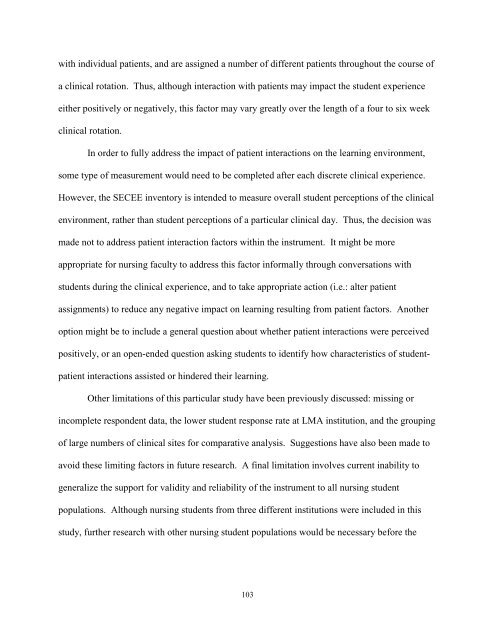STUDENT EVALUATION OF CLINICAL EDUCATION ENVIRONMENT
STUDENT EVALUATION OF CLINICAL EDUCATION ENVIRONMENT
STUDENT EVALUATION OF CLINICAL EDUCATION ENVIRONMENT
You also want an ePaper? Increase the reach of your titles
YUMPU automatically turns print PDFs into web optimized ePapers that Google loves.
with individual patients, and are assigned a number of different patients throughout the course of<br />
a clinical rotation. Thus, although interaction with patients may impact the student experience<br />
either positively or negatively, this factor may vary greatly over the length of a four to six week<br />
clinical rotation.<br />
In order to fully address the impact of patient interactions on the learning environment,<br />
some type of measurement would need to be completed after each discrete clinical experience.<br />
However, the SECEE inventory is intended to measure overall student perceptions of the clinical<br />
environment, rather than student perceptions of a particular clinical day. Thus, the decision was<br />
made not to address patient interaction factors within the instrument. It might be more<br />
appropriate for nursing faculty to address this factor informally through conversations with<br />
students during the clinical experience, and to take appropriate action (i.e.: alter patient<br />
assignments) to reduce any negative impact on learning resulting from patient factors. Another<br />
option might be to include a general question about whether patient interactions were perceived<br />
positively, or an open-ended question asking students to identify how characteristics of student-<br />
patient interactions assisted or hindered their learning.<br />
Other limitations of this particular study have been previously discussed: missing or<br />
incomplete respondent data, the lower student response rate at LMA institution, and the grouping<br />
of large numbers of clinical sites for comparative analysis. Suggestions have also been made to<br />
avoid these limiting factors in future research. A final limitation involves current inability to<br />
generalize the support for validity and reliability of the instrument to all nursing student<br />
populations. Although nursing students from three different institutions were included in this<br />
study, further research with other nursing student populations would be necessary before the<br />
103












